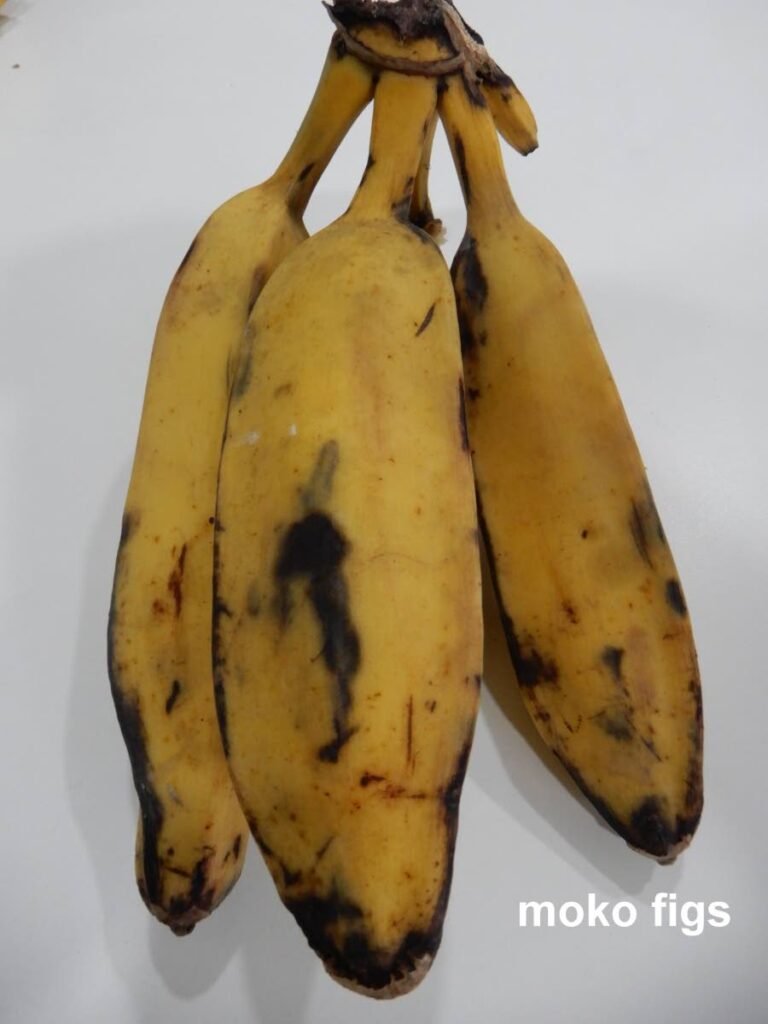
Moko figs, are in the banana family.
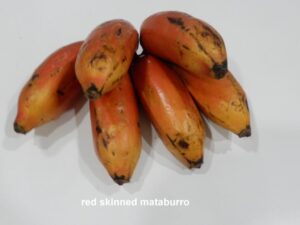
red moko called mataburro, or kill the donkey.
When Fernand Megellan, first credited with sailing around the world, met a new fruit he always called it some kind of fig, according to historians, This past week I had some moko figs, which are sweet non-starchy plantains. They were found cultivated on some nearby property. Whether a plantain or a banana, they are squarish like a plantain but sweet like a banana and despite warnings can be eaten raw (I ate five raw green ones over a few days and fried one.) Some call them cooking bananas and dessert bananas. Local names include buck-buck, and mafobay. They’re a good source of fiber, vitamins A, C, and B-6, and magnesium and potassium. A cup has less than one gram of fat, 2 grams of protein, 58 grams of carbs, three grams of fiber, 663 mg of potassium 23 mg of vitamin C, 0.29 mg of B-6, and 57 mg of magnesium. By chance I had a great grandmother (Eurora May Dillingham) who liked short red moko figs. Her sailing family were part of the Dillingham businessmen involved with starting commercial pineapples on Hawaii in the 1800’s. Moko figs were also cultivated there and are still listed as found on the islands.
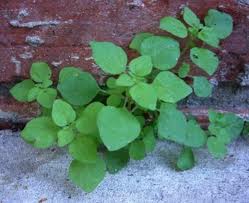
pellitory grows in the shade, Photo by Green Deane.
During our foraging classes this week we saw sprouts of the winter edible Pellitory. This shade-loving perennial shows up when fall weather starts and stays around until at least mid-spring. Some years in very shady places you can find old straggling specimens as late as July. It smells and tastes like cucumber thus is also called Cucumber Weed. It’s not a plant you find in the middle of a sunny field. Look for it in shady places such as under bridges, big trees and by hedges and walls. To read more about this winter comestible go here.
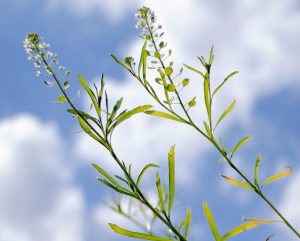
Seeding Poor Man Peppergrass. Photo by Green Deane
We also saw a plant that is here all year but strongy favors the wintertime: Poor Man’s Peppergrass. This Wasabi taste-alike definitely favors the cooler months and can be found everywhere locally. The most difficult thing about Peppergrass is that it always looks different in warmer climates. In northern areas it’s a two-year plant and is either a basal rosette of leaves or a seeding flower spike. Because seasons are amorphous locally it can be in any stage any time. So you might find it low with big, wide leaves, or tall with skinny leaves. You just have to learn to recognize it in all of its growth stages. One constant theme is that is always tastes the same though younger plants tend to have a stronger flavor than older plants. To read more about Peppergrass click here.
Florida’s beaches this time of year start to collect seaweed. It is nearly all one species, Sargassum; edible but not the tastiest of sea vegetables. It is true that nearly all seaweeds are edible if harvested from clean water. When I lived in Japan an annual environmental demonstration was to develop photographic film from unaltered water taken from Tokyo Bay. Instead of taking a few minutes, the developing took several hours but the point was made: The bay water was polluted. Generally said there are only two non-edible seaweeds in North America.
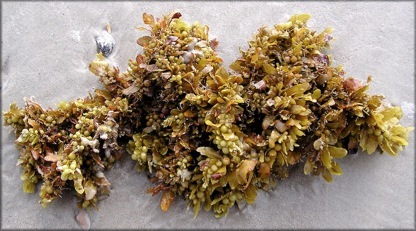
Sargassum: Edible but not the best of tastes.
The first is Desmarestia ligulata. It is laced with sulfuric acid but is used to make pickles. You can find it along the northwest coast of the United States. You’ll know it when you find it because it will burn your mouth. The other in North America (and Central America) is Cyanobacteria which is found in the Caribbean and linked to ciguarera poisoning. It’s not really a seaweed but is a blue-green algae found in the warmer waters. It is why one should never eat older barracuda. I should add never eat blue-green algae from fresh water either nor fish from a fresh water pond with a lot of blue-green algae. They are not on the menu. As for other parts of the world, there might be some toxic red seaweeds in the South Seas. Since most seaweed is edible, and nutritious, why isn’t it consumed more often? Taste and texture. I’ve collected Sargassum here in Florida and prepared it many ways. Semi-drying and frying isn’t too bad but Bladderwrack is better, Sea Lettuce better still. The latter makes very nice salads. Not surprisingly most land animals including birds don’t like seaweed. However, it does make good mulch and fertilizer. So while one may not use it directly in the diet it can still help sustain you with uses in the garden. During Victorian times it was highly used in English agriculture mostly as mulch and fertilizer. Here are some of my articles on seaweed: Bladderwrack, Caulpera, Codium, Gracilaria, Sargassum, Sea Lettuce, and Tape Seagrass.
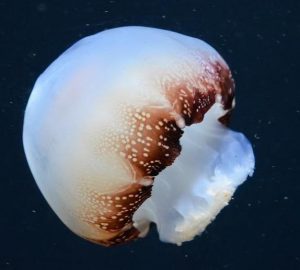
Stomolophus meleagris, one of our edible jellyfish.
While on the topic of the beach — I’m usually at Daytona Beach this week for a Greek festival, my birthday, and Veterans Day — many jellyfish are edible, including some that are found in local waters. I had a friend from Taiwan who never ordered from the menu at Chinese restaurants. It was always off-the-menu and then after much discussion with the waiter and sometimes the chef. One of those chats produced a dish of jellyfish. I was hooked. It was very tasty and jellyfish can be caught while casting for other fish. (I like castnetting and am a castnet junkie.) While a substantial food I’m not sure jellyfish would qualify as a staple because catching them by hand is by chance (which does increase however when in season.) They are also mostly water and need to be dessicated immediately, not a small process. It all depends on how hungry you are and how many of them you have. You should get them live out of the water, not dead on the beach. To read about jellyfish go here
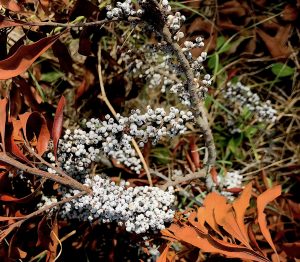
Southern Wax Myrtle berries. Photo by Green Deane
Just because you can do something doesn’t mean you should. Can you make a bayberry candle? Absolutely. Should you? If you have to, yes. If not you might want to reconsider. Southern Wax Myrtle berries are small. They have a little wax on them and why the species name is cerifera — wax producing. But it takes many gallons and a lot of hot work to get enough bayberry wax to mix with tallow (75/25) to make the famous smokeless candle that keeps away insects. No doubt hundreds of years ago it was worth it when folks had tallow from their own cattle, a lot of Bayberries and mosquitoes. Not so much today. But, you can use the dried berries as a spice and the leaves like bay leaves or to make a tea. To read more about the Southern Wax Myrtle go here.

Classes are held rain or shine (but not during hurricanes.)
Foraging Classes: Should have good weather this weekend.
Nov 11th Mead Garden: 1500 S. Denning Dr., Winter Park, FL 32789. Meet at the bathrooms, 9 a.m.
Nov 12th, Bayshore Live Oak Park, Bayshore Drive. Port Charlotte. Meet at the parking lot at Ganyard and Bayshore, 9 a.m.
Nov 18th Lori Wilson Park, 1500 N Atlantic Ave, Cocoa Beach, FL 32931, meet at the north bathrooms, 9 a.m. to noon.
Nov 19th , George LeStrange Preserve, 4911 Ralls Road, Fort Pierce, FL, 34981. 9 a.m. to noon.
To read more about the classes, to pre-pay or sign up, go here.
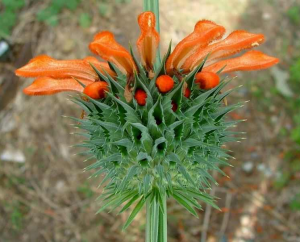
Leonotis nepetifolia and leonotis leonurus blossoms look the same.
There’s an innocent-looking ornamental plant in local parks which in some European countries the possession of which can get you 30 years in prison: Wild Dagga, or, Leonotis leonurus. As a student of Greek I always have an issue with the name because “Leonotis” means “Lion’s Ear” while “leonurus” is mangled Greek and “new” Latin for “Lion’s Tail.” So it’s name is Lion’s Ear Lion’s Tail…. more drunk botanical overkill. They took it all from the historical King of Sparta, λέωνῐ́δᾱς, or Leonida, which means “son of a lion.” A second species found locally — and more often — is Leonotis nepetifolia (catnip leaf.) The plants look similar except “lion tail” has skinny leaves like marijuana, and the “catnip leaf’ has somewhat large diamond-shaped leaves like catnip. The blossoms and over all growth pattern is similar for both. From tropical South Africa and India Lion’s Tail is used … recreationally… where as Catnip Leaf is used medicinally. Both have leonurine, Lion’s Tail apparently more than Catnip Leaf. Water extraction — blossom tea — is the common method. A 2015 study says Leonotis leonurus seems to be mildly pschoactive. “Research has proven the psychoactive effects of the crude extract of L. leonurus, but confirmation of the presence of psychoactive compounds, as well as isolation and characterization, is still required.” Sounds like a pitch for more research money. Others report both species contain marrubiin which is an analgesic and probably why they have been used in traditional medicine. Bees and humming birds also like the species. A relevant pubmed article can be read at: https://pubmed.ncbi.nlm.nih.gov/29016795/

You get the USB, not the key.
172-video USB would be a good end of spring present and is now $99. My nine-DVD set of 135 videos has been phased out. The USB videos are the same videos I have on You Tube. Some people like to have their own copy. The USB videos have to be copied to your computer to play. If you want to order the USB go to the DVD/USB order button on the top right of this page. That will take you to an order form. I’d like to thank all of you who ordered the DVD set over the years which required me to burn over 5,000 DVDs individually.

Green Deane Forum
Want to identify a plant? Perhaps you’re looking for a foraging reference? You might have a UFO, an Unidentified Flowering Object, you want identified. On the Green Deane Forum we — including Green Deane and others from around the world — chat about foraging all year. And it’s not just about warm-weather plants or just North American flora. Many nations share common weeds so there’s a lot to talk. There’s also more than weeds. The reference section has information for foraging around the world. There are also articles on food preservation, and forgotten skills from making bows to fermenting food.
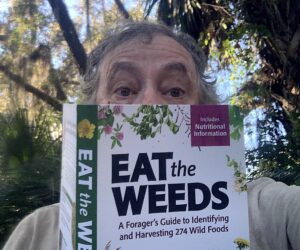
Finally, a physical copy of the book.
Now in print is EatTheWeeds, the book. It has 274 plants, 367 pages, index, nutrition charts and color photos. Several hundred have been pre-ordered on Amazon. Most of the entries include a nutritional profile. Officially it will be published December 13th (to suit the publisher publicity demands) and apparently to appeal to the winter market. Orders via Amazon are scheduled to arrive Dec. 5th.
This is weekly newsletter #579. If you want to subscribe to this free newsletter you can find the sign-up form in the menu at the top of the page.
This newsletter is late because mail chimp is increasingly difficult to wok with. Any one have a suggestion for a mailing service?

